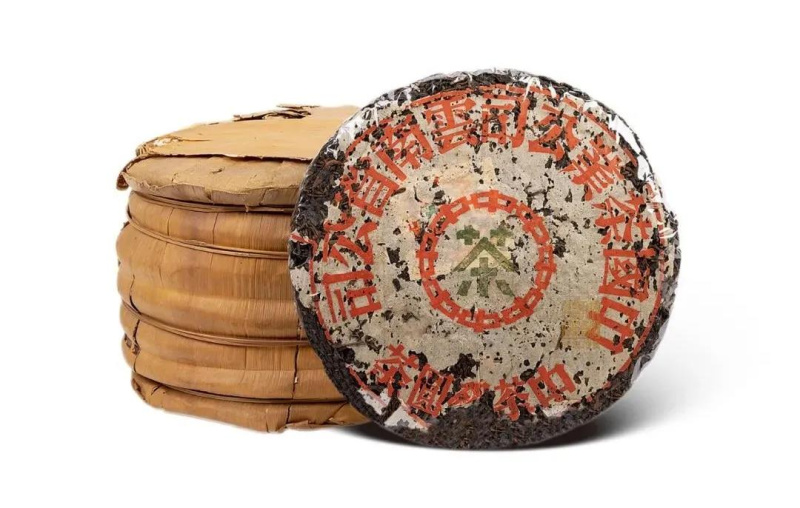A well-aged cake from one of the best tea factories made from raw materials from wild ancient trees, with inclusions of whole buds. The color has already transformed into brown shades, close to shu pu-erhs. A stone press was used - medium pressing, the cake is loose at the edges, if desired, you can disassemble it by leaves.
When warmed up with your breath, you can feel a bright fruity-compote aroma with melodic honey tones, notes of baked apple and wild apricot.
After washing, the aroma is transformed: powerful, sweetish, slightly smoky, with a distant resemblance to the beloved Soviet soda “Cream Soda”, ripe berries, and hints of apple juice.
The taste of brewed tea is soft, oily, aristocratic, as the Chinese say "Chun" (Chinese 醇), which means pure, active, whole, reminiscent of wine, the taste of alcohol (in China, good wine is also appreciated). The taste has a lot of baked apples, homemade pastille, apricot at the peak of ripeness, caramel fondant. If you overexpose it a little, then only a pleasant bitterness of apricot pits is added, quickly turning into sweetness, there is no bitterness.
As the infusions increase, this sheng becomes only softer, adding sweet confectionery notes with nuances of apple marshmallow, homemade candies, plum compote. By the end of the tea party, a pleasant candy sourness with a slight chill and tartness is felt.
The infusion literally melts on the lips, leaving a bright aftertaste with caramel, fruit, berry and honey notes, among which baked apple dominates. This flavor ensemble will be felt in the mouth for a long time.
Withstands a record number of infusions of 15 or more, based on 10 grams of dry tea leaves per 120 ml.
This tea has a strong, intoxicating tea effect. Meditative state, relaxation, deep immersion in oneself, order in thoughts, light pleasant dizziness, as if you drank a glass of aged expensive wine. Gently tones and encourages action, completely reboots and balances, you can feel the flow of Cha Qi in the body.
Sheng puer 2005 "Tea from wild trees" of the brand "Pine and crane" of the plant "Xiaguan" is a standard example of ideal aged tea, first-class raw materials from wild trees, amazing taste and absolute pleasure from the tea drinking process. Festive puer for thoughtful ceremonial tea drinking, has a collection value.
|
Name in Chinese
|
下關 2005年 野生七子餅茶 |
|
Pinyin
|
Xià guān 2005 nián yěshēng qīzi bǐng chá |
|
English name
|
Qizi bincha from wild-growing trees |
|
Translation
|
Tsitsi bincha from wild trees |
|
Country
|
China |
|
Provinces
|
Yunnan (云南) |
|
Region
|
Dali Bai Autonomous Prefecture (大理白族自治州) |
|
Manufacturer
|
Сягуань (云南下关沱茶集团) |
|
Raw material production date
|
2005 |
|
Year of pressing
|
2005 |
|
Pressing form
|
Bing Cha (Cake Tea) |
|
Tea tree (bush) variety
|
Gu Shu |
|
Fermentation method
|
In heaps |
|
Size
|
20x20x2 |
|
Length, cm
|
20 |
|
Width, cm
|
20 |
- Комментарии
- Вконтакте
Pu-erh is one of the most unique types of tea, which only gets better with age. Many people, when they first encounter this tea, wondered: why is pu-erh more often found in pressed form (cakes, bricks, tochas), and not in loose form? The reasons for this are related to both history and the practical aspects of storing and fermenting tea. Despite modern technologies that allow the production of loose pu-erh, the shape of pressed cakes remains unchanged. And pu-erh is more often found on sale in pressed form, for example, in the form of cakes or bricks, and loose pu-erh is less common. We will talk about the reasons for pressing pu-erh into cakes in this article.
Puer is a unique Chinese tea that is distinguished by its depth of taste, complexity of aromas and versatility of aftertaste. Its taste characteristics are formed under the influence of many factors, from growing conditions to the brewing method. Let's look at the main ones.





















































































